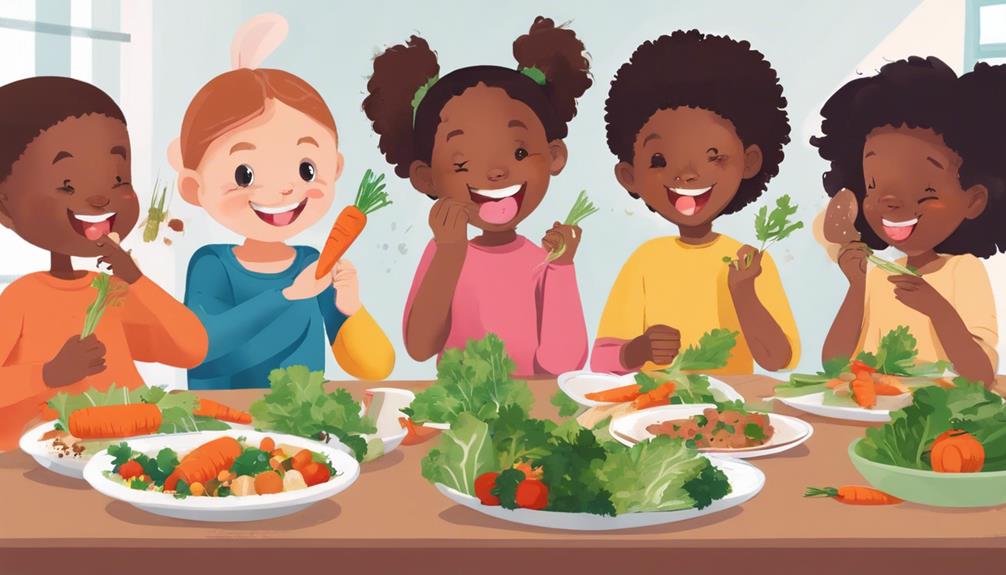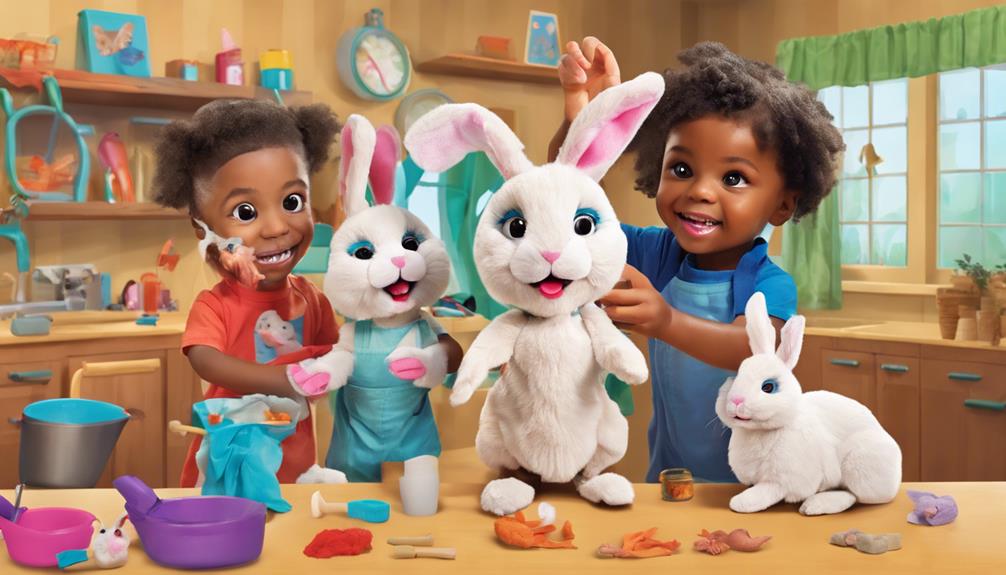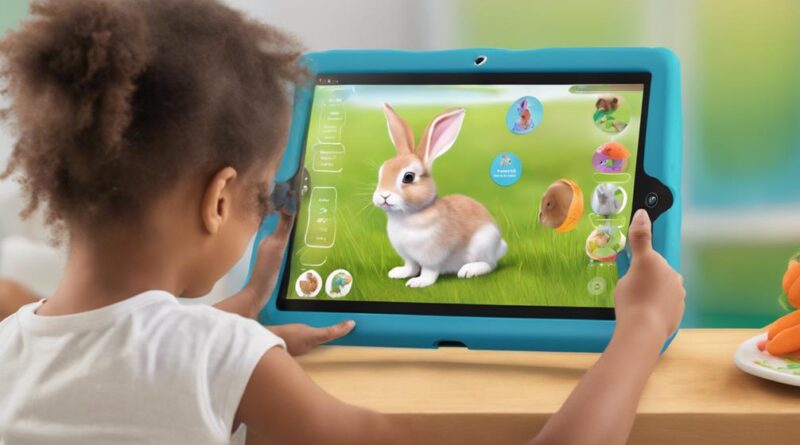10 Best Interactive Techniques to Teach Kids About Rabbits
To teach kids about rabbits, try these interactive techniques: Play a Rabbit Breeds Matching Game to learn about different types. Engage in Bunny Hopscotch for insights into rabbit care and behavior. Create a Bunny Origami Craft for fun and to boost fine motor skills. Explore a Rabbit Habitat Diorama to understand where rabbits live. Enjoy a Rabbit Storytime Adventure for interactive tales. Try a Bunny Scavenger Hunt to discover rabbit habits. Have a Bunny Coloring Contest to showcase artistic talents. Watch a Rabbit Care Puppet Show for lessons in proper care. Join a Bunny Gardening Workshop for a rabbit-friendly garden. Discover more exciting techniques for immersive learning.
Rabbit Breeds Matching Game
To introduce children to the diversity of rabbit breeds, engage them in a fun and educational Rabbit Breeds Matching Game. This activity is designed to enhance breed recognition through a memory game format while also incorporating bunny facts for a trivia challenge.
The Rabbit Breeds Matching Game involves a set of cards, each featuring a different rabbit breed. The objective is for the children to match each rabbit breed card with its corresponding breed name. This process encourages children to pay attention to the unique characteristics of each breed, such as fur color, ear length, and body size, fostering their ability to recognize and distinguish between the various rabbit breeds.
As children play the Rabbit Breeds Matching Game, they not only improve their memory skills but also learn interesting bunny facts associated with each breed. For example, they may discover that the Holland Lop has floppy ears or that the Flemish Giant is one of the largest rabbit breeds. By combining breed recognition with engaging trivia challenges, this activity offers a comprehensive learning experience that's both enjoyable and educational.
Through the Rabbit Breeds Matching Game, children can develop a deeper appreciation for the diversity within the rabbit species while honing their cognitive abilities in a playful and interactive manner.
Bunny Hopscotch Activity
Engage children in a dynamic and educational activity by introducing them to the Bunny Hopscotch game. This interactive game not only provides entertainment but also serves as a valuable tool for teaching kids about rabbit care and behavior.
In the Bunny Hopscotch Activity, children will learn about bunny nutrition, witness a rabbit exercise demonstration, explore a rabbit grooming tutorial, and engage in a bunny behavior study.
To begin, the Bunny Hopscotch game can incorporate a bunny nutrition lesson where children match different fruits, vegetables, and pellets to the specific dietary needs of rabbits. This activity helps kids understand the importance of providing a balanced diet for their furry friends. Additionally, during the Rabbit exercise demonstration, children can mimic bunny hops and jumps as they move through the hopscotch grid, learning about the active nature of rabbits.
Furthermore, the Bunny Hopscotch game can include a rabbit grooming tutorial where children pretend to groom a toy rabbit, emphasizing the significance of grooming for a rabbit's health and well-being.
Lastly, the activity can involve a bunny behavior study where children observe and imitate rabbit behaviors like thumping, grooming, and binkying, fostering a deeper understanding of rabbit communication and social interactions.
The Bunny Hopscotch game offers a fun and engaging way for children to learn essential aspects of rabbit care and behavior.
Rabbit Habitat Diorama
Introduce children to the concept of creating a Rabbit Habitat Diorama to deepen their understanding of a rabbit's natural living environment and behaviors. This interactive activity serves as a valuable tool for wildlife conservation education, as it allows kids to explore the importance of preserving rabbit habitats. By incorporating elements like rabbit burrows into the diorama, children can learn about the significance of these underground shelters for rabbits' safety and protection from predators.
When constructing the diorama, encourage children to consider the ecosystem in which rabbits live. Discuss rabbit predators, such as foxes and hawks, to shed light on the challenges these animals face in the wild. This hands-on experience fosters ecosystem education, helping children grasp the delicate balance of nature and the role rabbits play within their habitats.
Bunny Origami Craft
Discover the art of Bunny Origami Craft as a creative way to engage children in learning about rabbits and enhance their fine motor skills through intricate paper folding techniques. Bunny paper folding, also known as origami rabbit tutorial, is a fun and educational activity that allows kids to create adorable paper bunnies while learning about the characteristics of rabbits.
Origami, the traditional Japanese art of paper folding, offers a hands-on approach for children to explore their creativity and improve their dexterity. By following a step-by-step origami rabbit tutorial, kids can enhance their concentration and patience as they carefully fold the paper to form a cute bunny shape. This activity not only stimulates their cognitive abilities but also helps them develop spatial awareness and problem-solving skills.
Through Bunny Origami Craft, children can learn about the importance of precision and attention to detail. As they fold the paper to create different parts of the rabbit, such as the ears, body, and tail, they can gain a deeper understanding of rabbit anatomy and behavior. This interactive technique fosters a sense of accomplishment as kids successfully complete their origami bunnies, fostering a love for learning about rabbits in a hands-on and engaging way.
Rabbit Storytime Adventure
A Rabbit Storytime Adventure offers a captivating exploration of the world of rabbits through engaging tales and interactive learning experiences. Through rabbit storytelling, children are immersed in the enchanting world of these furry creatures. This interactive session often includes rabbit puppetry, where lifelike puppets bring the stories to life, captivating young minds and fostering a deeper understanding of rabbits.
During a Rabbit Storytime Adventure, children have the opportunity to engage in bunny role play, where they can pretend to hop, groom their whiskers, and nibble on carrot sticks, allowing them to embody the characteristics of rabbits and gain insight into their behavior. Additionally, a rabbit puppet show may be incorporated, where kids can watch as the story unfolds with the help of adorable rabbit puppets, further enhancing their connection to these lovable animals.
The Rabbit Storytime Adventure serves as a fun and educational way for children to learn about rabbits in a hands-on and interactive manner. By combining storytelling, puppetry, and role-playing, kids can develop a greater appreciation for these gentle creatures while expanding their knowledge of rabbit habitats, diet, and behaviors. This immersive experience creates a memorable learning opportunity that sparks curiosity and fosters empathy towards rabbits.
Bunny Scavenger Hunt
Embark on a Bunny Scavenger Hunt to engage children in a hands-on exploration of rabbit habitats and behaviors. This interactive activity won't only be fun but also educational, allowing kids to observe firsthand the world of rabbits.
Here's how you can make the most of your Bunny Scavenger Hunt:
- Bunny Anatomy Lesson: During the scavenger hunt, take the time to point out specific features of a rabbit's anatomy. Highlight the long ears, whiskers, and powerful hind legs that help them navigate their environment.
- Rabbit Behavior Study: Encourage children to observe and document the behaviors of rabbits they encounter during the hunt. Discuss how rabbits communicate, their grooming habits, and how they interact with their surroundings.
- Bunny Home Construction: As children explore different areas looking for clues, explain how rabbits build their burrows or find shelter in the wild. Discuss the importance of a safe and comfortable habitat for rabbits.
- Rabbit Diet Exploration: Integrate discussions about the diet of rabbits into the scavenger hunt. Point out plants that rabbits typically eat and talk about the importance of a balanced diet for their health and well-being.
Rabbit Food Taste Test

During the Bunny Scavenger Hunt, children can further explore rabbit behaviors by engaging in a Rabbit Food Taste Test activity. This hands-on experience allows kids to delve into the world of rabbits through sensory exploration. In the Rabbit Food Taste Test, children have the opportunity to taste and learn about different vegetable treats that are essential for a rabbit's diet.
The Rabbit Food Taste Test serves as a platform for nutritional education, teaching children about the importance of providing rabbits with a well-balanced diet. By trying out various vegetables that rabbits enjoy, such as carrots, leafy greens, and bell peppers, kids gain insight into the dietary needs of these small animals. Understanding the nutritional requirements of rabbits is crucial for their well-being, and this activity fosters that awareness in an interactive and engaging manner.
Moreover, the Rabbit Food Taste Test can also be used to introduce children to the concept of a feeding schedule for rabbits. Through this activity, kids learn about the significance of offering rabbits fresh vegetables daily and how consistency in feeding times contributes to their health. By actively participating in the Rabbit Food Taste Test, children not only expand their knowledge of rabbit care but also develop a deeper appreciation for these furry creatures and their dietary preferences.
Bunny Coloring Contest
Get ready to showcase your artistic skills in the Bunny Coloring Contest, where creativity meets rabbit-themed fun for children of all ages. Whether you prefer realistic colors or dreamy pastels, this contest is the perfect opportunity to express yourself while learning more about our furry friends.
Here's what you can expect from this exciting activity:
- Rabbit Anatomy Lesson: Dive into the world of rabbit anatomy as you carefully color each part of the bunny. Learn about their whiskers, ears, paws, and fluffy tails while adding your artistic touch to the drawing.
- Bunny Art Project: Transform a simple outline of a rabbit into a masterpiece. Experiment with different color combinations, patterns, and shading techniques to bring your bunny to life on paper.
- Bunny Behavior Study: Observe real rabbits or study videos to understand how they move, interact, and communicate. Use this knowledge to add personality and character to your colored bunny.
- Rabbit Life Cycle Exploration: Explore the different stages of a rabbit's life, from birth to adulthood. Consider incorporating elements of the life cycle into your coloring to create a story through art.
Get your coloring tools ready and let your imagination run wild in this Bunny Coloring Contest. Who knows, you might discover a new passion for art and rabbits along the way!
Rabbit Care Puppet Show

To effectively teach children about proper rabbit care, consider incorporating a Rabbit Care Puppet Show into your educational activities. This interactive Rabbit Care Workshop combines education with entertainment, making learning about rabbit care fun and engaging for kids. Puppet shows have been used as effective educational tools for decades, capturing children's attention and helping them retain information in an entertaining way.
During the Puppet Show, kids are introduced to the basics of rabbit care through a lively Puppetry Performance. The puppets act out different scenarios related to feeding, grooming, and handling rabbits, emphasizing the do's and don'ts of caring for these furry creatures. By watching the puppets demonstrate proper care techniques, children can visually understand what it takes to keep a rabbit happy and healthy.
Interactive Rabbit Care activities are interspersed throughout the Puppet Show to reinforce important lessons. Children may be asked to participate by feeding a puppet rabbit or showing the correct way to pet a rabbit gently. These hands-on experiences help solidify their understanding of proper rabbit care practices in a memorable way.
Incorporating a Rabbit Care Puppet Show into your educational program can effectively teach children the essential aspects of caring for rabbits while keeping them entertained and engaged. This innovative approach not only educates kids about responsible pet ownership but also fosters a love and respect for these adorable animals.
Bunny Gardening Workshop
Consider participating in a Bunny Gardening Workshop to learn how to create a rabbit-friendly garden environment. This interactive workshop provides valuable knowledge on cultivating a space that not only supports the growth of plants but also caters to the needs of our hopping friends.
Here's what you can expect to learn during the workshop:
- Planting Carrots: Carrots aren't only a favorite treat for rabbits but also a nutritious option. In the workshop, you'll discover the best practices for planting and maintaining carrots in your garden to ensure a fresh and accessible food source for your furry companions.
- Building Burrows: Rabbits love to dig and create burrows as part of their natural behavior. Understanding how to design and build burrows in a safe and controlled manner in your garden can provide rabbits with a space to exhibit their instinctual behaviors while keeping your garden landscape intact.
- Choosing Rabbit-Friendly Plants: Learn about different plant species that are safe for rabbits to nibble on. Discover how to incorporate these plants into your garden to create a diverse and appealing environment for both rabbits and humans.
- Creating Safe Boundaries: Establishing boundaries within your garden is essential to protect both your plants and the rabbits. Explore techniques for setting up barriers that deter rabbits from areas where they may cause damage while still allowing them to enjoy the garden space.
Frequently Asked Questions
Can Rabbits Be Potty Trained Like Cats and Dogs?
Yes, rabbits can be litter trained like cats and dogs. Understanding rabbit behavior is key to successful litter training. For indoor rabbits, training tips include providing a litter box in a quiet corner, using rabbit-safe litter materials, and rewarding your rabbit for using the box.
Consistency and positive reinforcement are crucial. With patience and the right approach, rabbits can learn to use a litter box just like other pets.
What Are Some Common Myths About Pet Rabbits?
Common misconceptions about pet rabbits often revolve around their behavior. One myth is that rabbits are low-maintenance pets, when in reality they require specific care and attention.
Another myth is that rabbits are solitary animals, but they actually thrive with companionship.
Understanding rabbit behavior can help dispel these misconceptions and ensure that your pet rabbit receives the proper care and enrichment they need for a happy and healthy life.
How Can I Prevent My Rabbit From Chewing on Furniture?
To prevent your rabbit from chewing on furniture, start by using bitter spray on the items they tend to nibble. Ensure your rabbit has plenty of appropriate toys to keep them entertained and distracted from the furniture.
Rabbit-proofing your home by keeping cords and other tempting objects out of reach can also help redirect their attention. Providing a variety of safe distractions will help discourage destructive chewing behavior.
What Are Some Alternative Names for Baby Rabbits?
When it comes to baby rabbits, also known as kits or kittens, you'll want to focus on bunny care to ensure their well-being.
Understanding rabbit behavior is key to raising healthy and happy kits. Providing a nurturing environment, proper nutrition, and social interaction are essential for their development.
Are There Any Specific Plants That Are Toxic to Rabbits?
When it comes to the rabbit diet, it's crucial to be aware of specific plants that can be toxic to rabbits. Some common examples include rhubarb, avocado, and nightshade plants. These can pose serious health risks to your furry friend.
Always ensure that your rabbit's diet consists of safe and appropriate foods to maintain their health and well-being. Keeping harmful plants away from your rabbit is essential for their overall health.
Conclusion
In conclusion, these interactive techniques provide engaging ways to educate children about rabbits. By incorporating games, activities, crafts, and hands-on experiences, kids can learn about rabbit breeds, habitats, care, and more in a fun and interactive manner.
These methods not only make learning enjoyable, but also help children develop a deeper understanding and appreciation for these furry creatures. Encouraging curiosity and exploration through these techniques can foster a lifelong interest in rabbits and their well-being.
